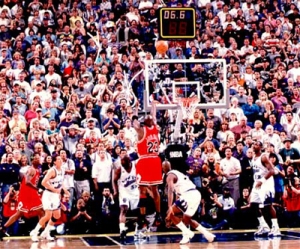Let's take a look at the playoff bracket:
Some very interesting match-ups ahead!
But in addition to trying to catch as many games as possible, I also wanted to take a stab at predicting who would become the 2012 NBA champions of course!
Just as in the previous posts, I will start off with a very simple model and work from there to improve its reliability.
So, what simple model can be establish to predict the outcome of the match-up between two teams? Let's simply consider the number of victories they obtained during the course of the season and derive a probability of winning a game from there.
Let us assume team 1 won 50 games and team 2 won 40 games. I would then grossly estimate that team 1's probability of winning a game against team 2 is 50 / (50 + 44) ~ 56%.
Similarly to many other sports, each match-up is a best-of-seven, meaning that the first team to win 4 games gets to advance to the next round. Therefore, if team 1 has a probability p of winning a game against team 2, team 1's probability of winning the match-up is:
P(win match-up) = p4 (1 + 4 * (1 - p) + 10 * (1 - p)2 + 20 * (1 - p)3)
Indeed, team 1 needs to win 4 games hence the p^4, and team 2 can win anywhere from 0 to 3 games with probability (1 - p). Depending on the number of games team 2 wins, the number of arrangements varies, yielding the 1, 4, 10 and 20. In the previous example, team 1 has an overall probability of winning the series of 62%, despite having won 25% more games during the season. This very simple framework can help explain the many upsets that are regularly witnessed.
So now that we can figure out the probability of team 1 winning its first match-up, we can go to the next step and figure out the probability that will win the series against the winner of the team 3 - team 4 match-up:
P(team 1 wins second round) = P(team 1 beats team 3) * P(team 3 beats team 4) + P(team 1 beats team 4) * P(team 4 beats team 3)
I started this script this morning when none of the games had been played yet, and obtained the following probabilities for each team of becoming the NBA champions:
| NBA team | Champion Probability |
|---|---|
| CHI | 15.0% |
| SAS | 14.4% |
| OKC | 11.3% |
| MIA | 10.5% |
| IND | 6.7% |
| LAL | 5.8% |
| MEM | 5.4% |
| ATL | 5.0% |
| LAC | 4.7% |
| BOS | 4.3% |
| DEN | 3.7% |
| ORL | 3.3% |
| NYK | 2.7% |
| DAL | 2.6% |
| UTA | 2.4% |
| PHI | 2.2% |
I re-ran the script after the results of today's first four games (good thing I'm single) and obtained the following similar results:
| NBA team | Champion Probability |
|---|---|
| CHI | 17.9% |
| OKC | 14.1% |
| SAS | 13.6% |
| MIA | 13.0% |
| LAL | 5.2% |
| MEM | 5.0% |
| ORL | 4.5% |
| ATL | 4.4% |
| LAC | 4.4% |
| IND | 4.1% |
| BOS | 3.8% |
| DEN | 3.4% |
| UTA | 2.2% |
| NYK | 1.6% |
| DAL | 1.5% |
| PHI | 1.2% |
Winning the first game did bump up the teams by a couple of percentage points, Oklahoma City now pulled in front of San Antonio.
But wait! Before you run to the closest sports betting bar to put down all your money on the Bulls, you should be aware that the current model doesn't account for certain external events such as... Derrick Rose tearing his ACL in the Bull's first game. The Bulls played great this year without Derrick in the lineup, but his absence is definitely going to hurt their chances...
Another surprise is the relatively low probabilities for the top teams of the season. Looking at the top 4 contenders, their cumulative probability of wining the title is barely over 50%. Again, this explains some of the regular surprises we see every now and again (every other year theoretically ;-) ).
There are many other caveats with this simple model, homecourt advantage is not taken into into account, nor is the fact that certain teams having already secured their playoff position rested their star players and lost games that were of no importance.
Nevertheless, I will try to continue improving the model and adress the current limitations. Naturally, I will also regularly post updated probabilities as the playoffs progress.
Now back to the replay of Kevin Durant's shot...



.jpg)
.jpg)


